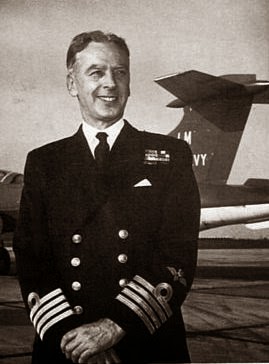I rarely do posts previewing upcoming interesting programmes or listing classic films on TV these days, partly because I no longer follow TV listings any more (without going into moaning mode, I haven't missed a TV mag because there's precious little of interest on). Other bloggers cover well the occasional runs of old films (usually, in the UK, on B.B.C. Two at some ungodly hour of the morning); I'm also mindful of the fact that some international readers have limited or no access to British programming.
Having said all that, here now is a worthy exception - a programme I had the good fortune to discover will be broadcast tomorrow (Sunday) evening at 9pm (BST) on B.B.C. Two. It features a hero of the Royal Navy's Fleet Air Arm, the consummate test pilot and a man who has flown more types of of aircraft - a staggering 487 all told - than any other human being in aviation history. He is Captain Eric "Winkle" Brown RN (Ret'd).
Without giving too much away - you'll have to watch the programme - Captain Brown, now 95 years old(!), joined the Royal Navy's Fleet Air Arm on the outbreak of World War II having actually been on a student exchange holiday in Germany at the start of the conflict in September 1939. He had visited the country several times previously in the 1930s with his ex-RFC father, including a trip to the 1936 Berlin Olympics where the Browns met and befriended German ace Ernst Udet. In September '39, in the first amazing incident of a long and action-packed career, the young Eric Brown was arrested by the SS. After three days of interrogation the 20-year-old Brown, quite incredibly, was simply escorted to the Swiss border - MG Magnette sports car and all - and sent on his way (when he somewhat impetuously asked his would-be captors why they weren't commandeering his car they replied "because we have no spares").
Captain 'Winkle' Brown: Is he the greatest pilot ever?
For the next 30 years Eric Brown would fly with the Fleet Air Arm, fighting German maritime bombers from aircraft carriers, testing captured German aircraft at Farnborough, as well putting new and prototype British and American aeroplanes through their paces - bravely pushing the envelope of flight - both on land and at sea. He still holds the record for most individual types flown, as well as being the first man to land a jet aeroplane on the deck of an aircraft carrier.
Now aged 95 Captain Brown still comes across as a fantastically knowledgeable and - of course - experienced chap, with the attitude and deportment that so typifies his generation. I can heartily recommend his autobiography Wings On My Sleeve and if it's even half as good as the book tomorrow's programme will be a real corker (looks like is is too!).
**Britain's Greatest Pilot: The Extraordinary Story of Captain Winkle Brown, B.B.C. Two, Sunday 1st June, 9pm**
(For readers outside the U.K., or without access to B.B.C. TV/iPlayer, here is a selection of extracts from a 100-minute interview with Eric Brown made 3 years ago).
 |
| source |
Without giving too much away - you'll have to watch the programme - Captain Brown, now 95 years old(!), joined the Royal Navy's Fleet Air Arm on the outbreak of World War II having actually been on a student exchange holiday in Germany at the start of the conflict in September 1939. He had visited the country several times previously in the 1930s with his ex-RFC father, including a trip to the 1936 Berlin Olympics where the Browns met and befriended German ace Ernst Udet. In September '39, in the first amazing incident of a long and action-packed career, the young Eric Brown was arrested by the SS. After three days of interrogation the 20-year-old Brown, quite incredibly, was simply escorted to the Swiss border - MG Magnette sports car and all - and sent on his way (when he somewhat impetuously asked his would-be captors why they weren't commandeering his car they replied "because we have no spares").
Captain 'Winkle' Brown: Is he the greatest pilot ever?
For the next 30 years Eric Brown would fly with the Fleet Air Arm, fighting German maritime bombers from aircraft carriers, testing captured German aircraft at Farnborough, as well putting new and prototype British and American aeroplanes through their paces - bravely pushing the envelope of flight - both on land and at sea. He still holds the record for most individual types flown, as well as being the first man to land a jet aeroplane on the deck of an aircraft carrier.
Now aged 95 Captain Brown still comes across as a fantastically knowledgeable and - of course - experienced chap, with the attitude and deportment that so typifies his generation. I can heartily recommend his autobiography Wings On My Sleeve and if it's even half as good as the book tomorrow's programme will be a real corker (looks like is is too!).
**Britain's Greatest Pilot: The Extraordinary Story of Captain Winkle Brown, B.B.C. Two, Sunday 1st June, 9pm**
(For readers outside the U.K., or without access to B.B.C. TV/iPlayer, here is a selection of extracts from a 100-minute interview with Eric Brown made 3 years ago).

















